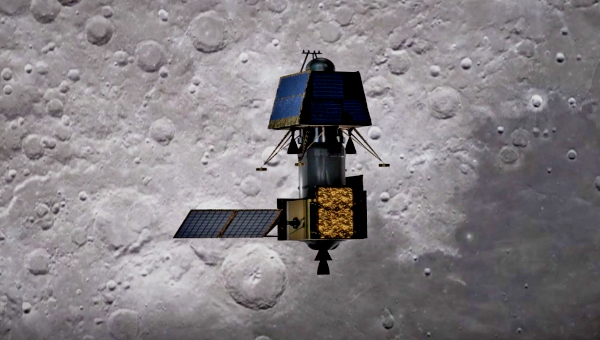BENGALURU: In a key event of India’s second moon mission Chandrayaan-2, lander ‘Vikram’ was separated from the orbiter on Monday, five days ahead of its planned lunar touchdown, space agency ISRO announced.
The separation of Vikram, which is set for soft landing on September 7 on the lunar surface along with rover ‘Pragyan’, was carried out at 1.15 pm and all systems of Chandrayaan-2 orbiter and the lander were healthy, it said.
The separation was carried out successfully, an official of the city-headquartered Indian Space Research Organisation told PTI.
The event came 42 days after the mission was launched onboard India’s most powerful rocket GSLV-MkIII-M1 from the spacesport of Sriharikota on July 22 and after a series of earth and lunar orbit manoeuvres, that took the spacecraft closer to the moon gradually.
The fifth and final lunar orbit manoeuvre was carried out on Sunday.
In a statement, ISRO on Monday said the lander, after the separation, was located in an orbit of 119 km perigee (closest point from moon) and 127 km apogee of the moons orbit.
The Chandrayaan-2 Orbiter, which has a mission life of one year, continues to go around the Moon in its existing orbit.
All the systems of Chandrayaan-2 Orbiter and Lander were healthy, ISRO said adding the health of the Orbiter and Lander was being monitored from the Mission Operations Complex at ISRO Telemetry, Tracking and Command Network (ISTRAC) here with support from Indian Deep Space Network (IDSN) antennas at nearby Bylalu.
After the separation, two deorbit manoeuvres of Vikram Lander, to bring it further down, will be carried out on September 3 and September 4 to prepare for its landing in the south polar region of the moon, where no country has gone so far.
The first of the manoeuvres was scheduled on Tuesday, between 08.45 am and 09.45 am Indian Standard Time,ISRO said.
Vikram, named after the father of Indias space research programme Vikram A Sarabhai, is scheduled to land on the lunar surface near its south pole on September 7 at about 1.55 am.
The exact landing site free of hazards would be decided based on pictures of the area captured and sent back by Vikram’s onboard camera.
Rover Pragyaan, a six-wheeled robotic vehicle, will then roll out from the lander to carry out various tests on the lunar soil, especially detecting the presence of water and other mineral there, during its mission life of one Lunar day, equal to 14 Earth days.
ISRO Chairman K Sivan has said the soft-landing on the Moon would be a “terrifying” moment as it is something the has not done before, whereas the Lunar Orbit Insertion maneuver was successfully carried out during the Chandrayaan-1 mission.
The orbiter carries eight scientific payloads for mapping the lunar surface and study the exosphere (outer atmosphere) of the Moon while the lander carries three scientific payloads to conduct surface and subsurface science experiments.
The rover carries two payloads to enhance the understanding of the lunar surface.
ISRO has said the objective of the Rs 978-crore Chandrayaan-2 mission is to develop and demonstrate the key technologies for end-to-end lunar mission capability, including soft-landing and roving on the lunar surface.
The mission aims at further expanding knowledge about the moon through a detailed study, leading to a better understanding of its origin and evolution.
On successful completion, it will make India the fourth country after Russia, the US and China to pull off a soft landing on the moon.
Source: ET
Image Courtesy: Planetary
You may also like
-
New Heat-Based Approach To Cancer Treatment Can Reduce Chemotherapy Doses
-
Scientists Take A Major Step Towards Unification Of Classical & Quantum Gravity
-
India Graphene Engineering and Innovation Centre (IGEIC) Under the Vision of Viksit Bharat@2047 Launched
-
New High-Performance Gas Sensor can Monitor Low Level Nitrogen Oxides Pollution
-
Antidepressant Drug can be Repurposed for Treating Breast Cancer
